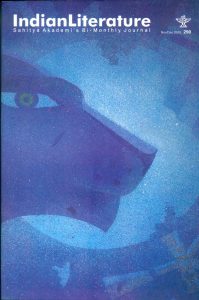SF in India: Indian Science Fiction Magazines
 In the West, science fiction has been shaped by magazines like Astounding, Asimov’s Science Fiction, Locus, Galaxy, Amazing Stories, Analog, Lightning Speed, Destiny, Galileo, Asimov’s, F&SF, New Worlds, Vertex, and others. Editors like Hugo Gernsback and John W. Campbell took a keen interest in directing the respective authors to write stories as the days demanded. Unlike in the West, India has had no history of science fiction magazine in general and editors in particular.
In the West, science fiction has been shaped by magazines like Astounding, Asimov’s Science Fiction, Locus, Galaxy, Amazing Stories, Analog, Lightning Speed, Destiny, Galileo, Asimov’s, F&SF, New Worlds, Vertex, and others. Editors like Hugo Gernsback and John W. Campbell took a keen interest in directing the respective authors to write stories as the days demanded. Unlike in the West, India has had no history of science fiction magazine in general and editors in particular.
Likewise, there were no critical journals in India like Science Fiction Studies, Extrapolation, Foundation, A Speculative Literature, Journal of Fantastic in Literature, and others which could generate criticism and book reviews.
Individual authors wrote SF stories and sent them for publication to general fiction magazines, where they appeared if publishers thought they might boost sales and popularity. Most of the stories were written by authors without a science fiction background, had no science basis, and were anti-science. Some of them had thin layers of scientific principles without proper authentication, or were contemporary fiction projected to future centuries or set on other planets. Many stories were translations of Western SF stories, often localized with Indian names and locations.
Root Causes
First, out of the known 1,635 Indian languages spoken in India, the constitution of India has recognized 22 as official languages. Among these Indian languages, only Hindi, Bengali, Tamil, Kannada, Telugu, and Marathi have published stories in magazine form. Second, the impact of industrialization was felt late in this country. Due to the population explosion, people felt that machines might steal their jobs and human beings might lose their livelihood. As a result, science fiction stories did not find a welcome in many of the magazines. The third factor might be that the people hesitated to cross the threshold from religious to scientific belief. People found solace in performing religious rituals and wanted to revive myth rather than recognize science and technology. Fourth, readers thought ‘‘science fiction’’ was oxymoronic; science and fiction didn’t go together. Scientists believed in science, and not in the positive effects of narration. The nonscience readers found thrills in plot, characterization, themes, and punch lines, rather than recognizing the importance of scientific and technological points of view. Fifth, few of the authors knew the rudimentary rules of science fiction stories and the basic differences between realistic fiction and SF.
A notable Bengali science fiction story, Jagadananda Roy’s ‘‘Shukra Bhraman’’ (Travel to Venus), was published in 1879. The first Indian science fiction story in Hindi was a serial written during 1884-88 by Ambika Dutt Vyas entitled ‘‘Aaschary Vrittant’’ (The Strange Tale) which was published in Peeyush Pravah, a magazine from Madhya Pradesh. Influenced perhaps by the adventure stories of Jules Verne, ‘‘Aaschary Vrittant’’ presented the captivating saga of one Mr. Gopinath, the protagonist who took a breathtaking adventurous journey underneath the Earth.
In the Hindi language, Jules Verne’s Chandra Lok Ki Yatra (Journey to the Moon), translated by Keshav Prasad Babu Singh, appeared in Saraswathi on November 6, 1900. ‘‘Ashcharya ki Ghanti’’ (A Wonderful Bell) by Sathya Dev Parivarjak was published in 1908. During those years Kishorilal Goswamy, Lala Shivnivas Das, Gopal Babu, Ram Gahwari and others also contributed stories which combined science elements with fairy tale themes. In Malayalam, SF writing started late around 1910 with the publication of a translation of Jules Verne’s Journey to the Moon, serialized in a magazine named Kerala Kokila printed and published in Cochin, Kerala state.
The Second Wave
Probably due to the negative impact of WWII, the development of SF in India suffered a hitch, but the movement gained momentum in the ’60s as science and technology progressed. Indian SF was impacted by the success of humans landing on the Moon, the discovery of quarks, the advent of TV, computers and the internet, deciphering the human genome, and cloning. With these elements in the background, people in the scientific world began writing science fiction in journals with the aim of popularizing science.
Indian Languages
‘‘Mini Noise’’ (1966) by Saurabh Kumar Chaliha, published in the magazine Asom Batori, is the first story in the Assamese language which has all the attributes of SF. It deals with controlling noise pollution.
SF progress has been remarkable over the past four decades as special editions of Bihu and Durga Puja paved the way for the publication of SF stories in some of the Bengali and Assamese magazines.
In the Tamil language, Kumudam and Ananda Vikatan were the two popular magazines which brought out SF stories. Mr. S. Rangarajan (Pen name: Sujatha), an electronic engineer by profession, served as the editor of Kumudam for some time. During his tenure, he contributed a number of SF stories and serialized them in the said.
In Telugu language, Chakumakhi is a science magazine for children which has been publishing SF stories. Online magazine Sanchika has published SF, with SF writer Kasturi Muralikrishna as its chief editor. Dr. Madhu Chittavru and Salim IRS have contributed regularly to the magazine since its founding three years ago: <sanchika.com>.
In the Kannada language, Mayura, Sudha Taranga, Tushara, Prabudha Karnataka, Koravanji, Bala Vigyan, and other popular magazines publish SF occasionally. Special issues of SF stories have appeared from Tushara and Mayura in the past. Kutuhali is an online science journal in Kannada edited by Kollegala Sharma. Since the postpandemic period, it has been publishing SF stories, and brought out a special SF issue in 2022.
 Kalpabishwa is the biggest online Bengali-language SF magazine, founded January 2016. Dip Ghosh is chief editor, with an editorial board consisting of prominent SF writers Santu Bag, Goutam Mandal, Pramit Nandi, and Supriyo Da. They publish original SF, translated works, and articles at <www.kalpabiswa.com>.
Kalpabishwa is the biggest online Bengali-language SF magazine, founded January 2016. Dip Ghosh is chief editor, with an editorial board consisting of prominent SF writers Santu Bag, Goutam Mandal, Pramit Nandi, and Supriyo Da. They publish original SF, translated works, and articles at <www.kalpabiswa.com>.
Kalpabishwa was generous enough to share with this author a few more names of Bengali science fiction magazines, including Aschorjyo (1963-’70s), followed by Bismoy (early ’70s). Fantastic ran from the early ’70s to 2000, and was followed by Anandamela, Shuktara, Kishor Varati, Sandesh, and Kishor Gyan Bigyan. Some Bengali general fiction magazines also occasionally published SF.
Vigyan Katha is the first prominent Hindi SF quarterly, published in print from Uttara Pradesh. Though globally many magazines have shut down for various reasons, chief editor Rajeev Ranjan Upadhyaya has produced his magazine with zeal, publishing it for 22 years without interruption. The 80th issue was released for October-December 2023 with guest editor Harish Goyal, the Hindi science fiction Badshaw (King). The issue featured works by established writers Rajeev Ranjan Upadhyaya, Arvind Dubey, Zeashan Haider Zaidi, and Harish Goyal. In addition, there are two more popular Hindi magazines, Vigyan Pragati and Electroiky Aapke Liye, which include at least one SF story each month.
SF in the Marathi language has a long history, since the ’70s. Among several print and online magazines, the most prominent are Srushtidnyan, Marathi Vidnyan Parishad Patrika, and Vidnyandhara, recently started by Grantali publisher. In addition, the science-based Marathi Vidnyan Vishwa often publishes SF stories in a number of special issues during the Diwali festival period.
Journals in English
Arya Madan Mohan came from London to settle in New Delhi and created the website <www.indianscifi.com>, and served as webmaster and chief editor for a year or two. He was the first publisher who offered payment of INR 2000 per story.
The Indian Association for Science Fiction Studies was established for the promotion and development of research in the field of SF, and was formerly located at Vellore, Tamil Nadu. The publication division of the association published SF stories, scholarly articles, letters to the editor, guest columns, and the reports of the conferences held during those years in its quarterly print magazine, Indian Journal of Science Fiction Studies, from January 2000 to December 2005. Dr. Purushothaman, the first among the scholars to obtain a doctoral degree in science fiction in India, was the founder-president of the association and chief editor of the scholarly journal.
Mithila Review, an online quarterly magazine in English, was founded by Salik Shah, with its inaugural issue launched in March 2016. It became a paying market in 2016. The magazine relies primarily on donations and subscriptions as sources of funding through.
Online magazines Kalkion and Muktware published Indian SF stories in English, but both shut down around 15 years ago.
Adbhut.in is the only English-language online magazine consistently publishing a variety of Indian SF works, including original stories, articles, interviews, panel discussions, and book reviews. It was founded at the turn of the century. Each item in every issue has catchy images and sketches. The webzine has found success because of the persistent effort of its chief editor, the prolific writer and scholar Dinker Charak.
Science Reporter is an English-language print magazine that publishes reports of SF conferences in India. It conducted a science-fiction story writing competition during the year 2023, publishing the winners.
 Indian Literature is a renowned bimonthly print journal published by Kendra Sahithya Academy, and brought out a special SF issue in January-February 2024. The issue has several sections, including graphic narratives and Bengali, English, Dogri, Hindi, Malayalam, Telugu, Punjabi, and Kannada language representations, as well as several essays, poetry, and extracts showing the breadth of Indian SF.
Indian Literature is a renowned bimonthly print journal published by Kendra Sahithya Academy, and brought out a special SF issue in January-February 2024. The issue has several sections, including graphic narratives and Bengali, English, Dogri, Hindi, Malayalam, Telugu, Punjabi, and Kannada language representations, as well as several essays, poetry, and extracts showing the breadth of Indian SF.
Conclusion
Publication of SF stories in Indian magazines can be traced back to Amazing Stories in 1926. But the Indian SF magazines are quite different from those produced in other countries in the world. The author of this article is quite ignorant to read, write, and converse in most of the Indian languages, with the exception of Hindi, Kannada, and Marathi. Thus, it is difficult to go deeply into the print media of other Indian languages for a comprehensive scholarly study.
However, as James Gunn wrote, stories about ‘‘the fear of the machine, fear of the creature rebelling against his creator… people without depth of thought, religious fanatics, short-sighted unions’’ were common among Indian SF work published in previous centuries. Most of the common people believed in the unbelievable. Some of them were on the threshold of skepticism and rationality. Most of the Indian SF works in the last century show the impact of Mary Shelley’s Frankenstein, R.U.R. by Karl Capek, the novels of H.G. Wells, ‘‘The Machine Stops’’ by E.M. Forster, and others.
But year by year, the stories have progressed toward skepticism and rationalism, and there’s a strong tendency toward more positive works. Hope and optimism, the ‘‘mantra’’ of science fiction philosophy, are more noticeable in the content and form of Indian SF stories lately. From the turn of the present century until today, the stories which find publication reflect human-machine symbiosis and deal with the contemporary problems like climate change, alien encounters, terraforming, colonizing alternate worlds, the search for alternative energy sources, artificial intelligence, the positive and negative impact of ChatGPT, and other topics.
There was a survival problem for print magazines during the past century, as the sales were poor in the local market. The present-day journals, especially the online ones, have overcome such difficulties. But there are other problems which have to be addressed, including technological and financial resources, dedicated staff, and the impact of AI submissions.
–Srinarahari Hanumanthan Mysore
IF YOU ENJOYED THIS ARTICLE, please take a moment to support what we do! Our annual fund drive ends April 5. We must meet our funding goals to continue!
This report and more like it in the March 2024 issue of Locus..
 While you are here, please take a moment to support Locus with a one-time or recurring donation. We rely on reader donations to keep the magazine and site going, and would like to keep the site paywall free, but WE NEED YOUR FINANCIAL SUPPORT to continue quality coverage of the science fiction and fantasy field.
While you are here, please take a moment to support Locus with a one-time or recurring donation. We rely on reader donations to keep the magazine and site going, and would like to keep the site paywall free, but WE NEED YOUR FINANCIAL SUPPORT to continue quality coverage of the science fiction and fantasy field.











